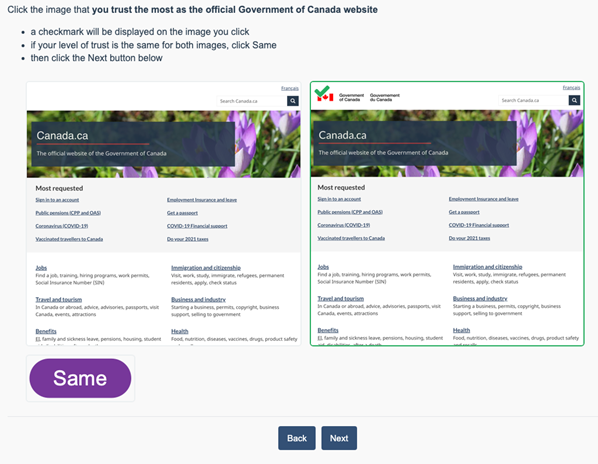Trust study: Canada.ca design elements: Research summary
In recent years, Canada has seen an unprecedented number of fraud casesFootnote 1. Many of these cases target their victims through websites that attempt to look like official sites. This makes it more important than ever to ensure that users can recognize official Government of Canada (GC) websites.
Consistency in design is a crucial element to help foster trust among users. Our Wayfinding research project suggested that consistent design elements across pages increased trust that users were on official Government of Canada sites.
The Canada.ca Experience Office (CEO) conducted a Trust study to better understand which Government of Canada design elements are more strongly associated with trust and confidence in the brand. The study measured and compared respondents' trust in the following:
- Federal Identity Program (FIP) flag signatures
- Canada.ca domain
- Theme menu button
- Sign-in button
The findings demonstrated that the Government of Canada signature, that includes the flag symbol, was essential to the brand and that the use of the red flag provides the highest level of trust. The Canada.ca domain, as well as a consistent Sign in pattern were also identified as being important to user trust. In contrast, the theme menu button was not an essential design element to user trust.
Method
We conducted an interactive trust exercise from June 9 to 22, 2022. The exercise had 2,726 respondents, recruited via an invitation on Canada.ca. There were 4 versions of the study across both official languages and a mobile vs computer layout. 48% of participants answered from within Canada. 78% responded in English, and 73% completed all the questions.
For each question, people were shown 2 images with slight variations of brand elements. They were asked to identify which image they found more trustworthy. If their level of trust was the same for both images, they could respond with "same".

Image description: Interactive trust exercise
A sample of the survey experience for respondents using a desktop computer. Two similar Canada.ca webpages are displayed side-by-side. The survey tells the user to click the image that they trust the most as the official Government of Canada website. If they trust them equally, the user is instructed to click "same".
Before fully launching the study, we piloted it with 35 people. These respondents explained their answers via screen-recording sessions. This qualitative stage served both to refine the study design and to get a detailed understanding of rationales and drivers for particular choices. We were particularly interested in people's ability to differentiate between trust and preference.
These early answers showed that while there is some overlap between trust and preference, most understood the difference. Respondents described their trust choices most often with terms like "safe", "official", "professional". In the closing comments section, they often mentioned the red flag symbol in the upper left corner.
What we learned
The study showed that the Government of Canada signature with a red flag symbol and black type, on a white background, has the highest level of trust of the Canada.ca brand. The vast majority of respondents trust this version more than any other version of the GC signature.

Only 8% of respondents chose the page without the flag as trustworthy. The flag was often mentioned, with comments such as:
- "This flag makes me feel as if it's more safe"
- "It has Government of Canada in both official languages with the flag so I trust this one more"
- "The flag makes more sense, the other doesn't feel official"
Red trusted more than black and white
When presented with the official FIP flag symbol in red and in black and white, participants trusted the coloured version of the flag more. According to the study:
- 74% trust the coloured flag more
- 5% trust the black and white flag
- 21% chose "same"
These results were consistent across age and type of device.
The study found that specifically, the background of the image should be white, ideally even in dark mode, to make the flag stand out. The black and white version seemed to hit a nerve with respondents, as it was often mentioned in the closing comments. We received comments such as:
- "The flag in upper left should be in colour"
- "The red leaf flag is most trusted"
- "The flag should have red and white, never black and white"

Image description: Government of Canada FIP symbol trust test
On the left, a page related to jobs for youth displays the colour version of the FIP flag symbol. On the right, the same page displays the symbol in black and white.
Canada.ca domain more trusted than .gc.ca
The study asked respondents to choose between URLs using the Canada.ca domain and the gc.ca domain. 60% of participants trusted the Canada.ca URL more than a similar .gc.ca URL. The Canada.ca URL is particularly important to the many people who've learned they should trust URLs more than the design.
- "The URL not only includes but starts with canada.ca, anything other worries me that the site is not official or being spoofed"
Menu button isn't essential to the brand
We found that the menu button was not essential to user trust. When shown designs with and without the menu button, 41% of respondents chose "same". This demonstrated that they didn't notice the difference, or were equally trusting, in both designs. This was the only question in the study where more people chose "same" more often than one of the images.
Sign in needs consistent design across accounts
Signing in to an account is sometimes associated with phishing and spoofing so we wanted to determine what sign in design is more trusted. We included a study question which displayed images of an account sign in page. One version had a familiar Canada.ca green "supertask" button. The other version had unique blue and red buttons. 43% of the respondents trusted the page with the green buttons. 37% trusted the page with unique buttons.
Respondents mentioned the importance of consistency and familiarity for sign in pages. They expect a consistent design for the Canada.ca brand to help them avoid fraud.
Other findings
In respondents' final open-ended comments, there were many mentions of desiring a better user experience. Users want Canada.ca to be simpler and more functional. We encourage departments to continually improve their web presence using research and evidence. Tools such as the GC Task Success Survey and GC Feedback can help you gather evidence and decide what to improve next.
GC Task Success Survey: The GC Task Success Survey is a continuously running web intercept survey that asks questions related to three key elements: task success, ease, and satisfaction.
GC Feedback: This tool allows users to provide feedback for the page they are on. It can help departments uncover common issues in their content.
Next steps
As a result of this research, we updated the global header guidance in the Canada.ca design system to reflect the importance of the red FIP flag symbol and to provide a consistent spot for the Sign in button. We also continue to work with departments and agencies to ensure full adoption of the Canada.ca design, including the Canada.ca domain. In addition, we're collaborating with departments and agencies to develop a consistent sign in pattern.
Page details
- Date modified: